- Space Renaissance International, Tulln, LL, Austria
The utilization of the natural resources of our Moon and the near-earth asteroids (NEAs) for the benefit of humankind will need industrial plants in space. There are a number of possible locations for the deep-space processing of extracted space-based materials and future industrial activities in cis-lunar space. Prime among these are the Moon itself and the Earth’s five Lagrange points which provide equilibrium between the gravity forces of the Earth and Moon. Especially in Lagrange points L4 and L5, objects remain in stable positions because of the triangle between the object, Earth, and Moon. Building the first space factory in L5, for example, will enable the processing of material and production of goods in zero gravity. Unlike on Earth or the Moon, solar power would be available for 24 h. The industrialisation of cis-lunar space will start with the mining of our Moon. The Lagrange Space Factory (LSF) would start with the processing of lunar material and extract aluminum, iron, titanium, and other materials from lunar regolith. When the metals are extracted from oxides, oxygen is a byproduct. An additional source for material would be the recycling of orbital debris to clean up Earth’s orbit. In the long run, the LSF would also process NEA material, including gold, platinum, and carbon. C-type (carbonaceous) asteroids also contain water ice and organic molecules. The goal would be to produce building material like steel bars and aluminum panels, tubes, and bricks for future space habitats. Oxygen and space-made propellant could also be produced. The isotope helium-3 is abundant on the Moon and can be used for future nuclear fusion in space and on Earth.
Preface
This paper has been created and written by humans. No artificial intelligence was used, neither for the text nor for the figures. It is based on the paper IAC-24,D4,5,15,x80,944 “Industrializing the Earth–Moon System—the role of space mining and material processing for human civilization on Earth and in space”.
Introduction
To provide a liveable environment for nine or ten billion humans on Earth, we will have to utilize the natural resources of the solar system—preferably those of our Moon and of the near-earth asteroids (NEAs). In the long run, most mining and heavy industry could be established in space to turn “Mother Earth” into a “green planet” without man-made pollution and global warming. By developing nuclear fusion plants using helium-3, which is rare on Earth but abundant on the Moon, anthropogenic global warming could be reduced significantly and provide electric energy for millennia.
Unlike on a single planet like Earth, there are no limits to growth in outer space. In the long run, we can build self-sustainable rotating space habitats with simulated gravity using lunar and asteroid material, thus finally establishing human civilization in the solar system. In case of natural cataclysms, such as asteroid impacts, novae, or super-volcanoes, extraterrestrial human settlements will guarantee the survival of the human species (Autino et al., 2022).
Lunar natural resources
Lunar regolith is a layer of broken rock and dust particles which covers the bedrock of our Moon. It is the result of billion years of meteorite and asteroid impacts on the lunar surface and is composed of mineral fragments, melt glasses, and glass beads and agglutinates. The depth of the regolith layer is estimated to be between 4 and 5 m in mare areas and 10–12 m in the highlands (McKay et al., 1991). The size of regolith particles varies from sub-micron to stadium-sized boulders on the surface, but most particles are below 1 cm (Edmundson et al., 2012). The average bulk density is approximately 1.5 g/cm3, including the voids.
Table 1 shows the composition of Apollo soils smaller than 1 mm in oxide weight percent.
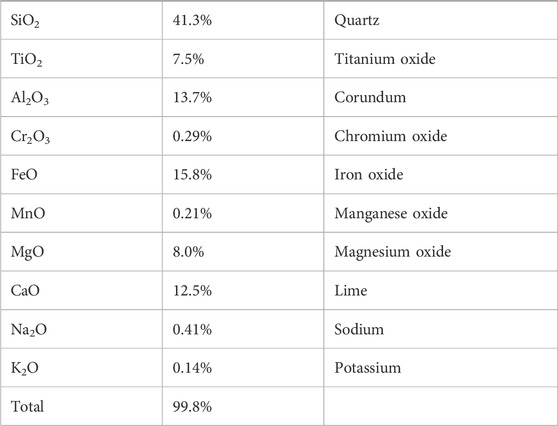
Table 1. Composition (weight percent) Apollo sample number 10084, split number 1591 (Papike et al., 1982).
Helium-3 (He-3) is a rare isotope of helium on Earth that has many important uses, including low-temperature physics research, medical lung imaging, neutron detection, and potential nuclear fusion (Fetter, 2010). Fusing deuterium and He-3 to He-4 + protons releases 18.3 MeV of energy per reaction (Bussard, 2002). According to Wittenberg et al. (1986), the Moon contains approximately 1 million tons of He-3 implanted into the lunar regolith by the solar wind. If regolith is heated to extract all volatiles, the evolved gases can be compressed and separated. He-3 can then be brought to Earth or to industrial plants in space as a liquefied gas (Kuhlman et al., 2012).
Some craters of the lunar South Pole region have permanent shadowed areas with a temperature of 40–100 K. Not only hydrogen molecules could have been trapped in these areas, but also sulfur dioxide, formaldehyde, ammonia, methane, and others. In 2009, NASA’s LCROSS mission detected water ice in significant quantities in the permanently shadowed Cabeus crater (Schwandt et al., 2012). It is estimated that approximately 5% of the targeted crater’s soil consists of water ice (Colaprete et al., 2010).
Near-earth asteroid resources
In recent decades approximately 20,000 NEAs have been detected, and their number is still increasing. Their sizes range from several meters to some hundreds of meters or even kilometers in diameter. There are three main classes of NEAs: Amors, Atens, and Apollos (Shoemaker et al., 1979). The Amors orbit the Sun beyond Earth’s solar orbit, while the Atens can be found in a region closer to the Sun and approaching Earth by 0.983 AU (astronomical unit = average Sun–Earth distance of 150 million kilometers). The Apollos are the most numerous group of NEAs and differ from the Amors in their minimum distance from the Sun, which is approximately 1.017 AU. The biggest known Apollo is 1866Sisyphus with a diameter of approx. 10 km, while the largest known Amor is 1036Ganymed at about 32 km in diameter. Some of those bodies may intersect the Earth´s solar orbit and cause collisions. On one hand, we will have to develop methods of detection and deflection techniques for hazardous NEAs, while on the other hand, we can use these technologies to modify their orbits and exploit their natural resources. Modifying the solar orbits of asteroids, such as forcing them from a solar into an Earth orbit beyond the Moon, can be done using future advanced nuclear fusion rocket engines like the Bussard Fusion System (Bussard, 2002; Grandl et al., 2013).
Geochemical analysis of meteorites found on Earth shows typical groupings of elements (Krot et al., 2003; Mittlefehldt, 2003). One group are the “siderophile elements” that are related to nickel–iron. The second group is related to iron–sulfide, characterized by the “chalcophile elements.” A third group are the “lithophile elements” related to oxygen, enriched in the silicate parts of meteorites and asteroids. Table 2 shows the geochemical groups of meteorites with typical elements occurring in mineral associations, with numerous metals and rare-earth-elements needed for space-based industry and on Earth.
The roughly estimated total mass of all NEAs larger than 1 m is approx. 50 trillion metric tons. The average bulk density of NEAs is supposed to range from 1 to 5 g/cm3. Just 2%–4% of all NEAs are metallic, containing nickel–iron and platinum group metals. The majority are stony or carbonaceous. If spectral analysis is uncertain, we could send probes to these celestial bodies.
Potential asteroid mining and utilization
A first source of asteroid material and for initially testing small asteroid harvesting methods are the natural Earth satellites, or “temporarily-captured orbiters” of Earth. These are a cloud of small bodies 0.1–10 m in diameter surrounding the Earth at any given time. Only asteroid 2016HO3 is approximately 100 m in diameter (Granvik et al., 2013). Figure 1 shows a conceptual design of robotic space tugs catching a small asteroid 10 m in diameter. The captured object would be transported to the proposed L5 space factory for further processing. Such space tugs can also be used to collect orbital debris and for any cis-lunar cargo transport.
In Grandl et al. (2013), the near-Earth asteroid 2008EV5 was taken as an example of a mining concept. This celestial body is a typical Aten group asteroid, with a mean diameter of 450 m. It belongs to spectral type S (stony asteroids) and is supposed to have an average bulk density of 3 g/cm3. The asteroid was assumed to have a metal core, a silicate mantle, and a crust with an estimated mass of approximately 140 million tons. To reach the metal core, a tunnel would be drilled to the asteroid’s centre. First, a manned mining station would be docked to the asteroid (Figure 2) containing a tunnel boring machine (red), conveyance and processing machinery (yellow), storage and docking modules (blue), and rotating habitat modules (green) to provide simulated gravity for the crew. Electric current is provided by solar panels and a nuclear battery. The tunnel boring machine must work more slowly, smoothly, and precisely than in a terrestrial mine to not disturb the structural stability of the asteroid rock. It would drill a central tunnel 8 m in diameter to the metal core of the asteroid and then excavate step by step a spherical cave up to 50% of the asteroid´s volume. The remaining hollow celestial body could be used for storage or an industrial facility, or even to build a human settlement inside the cave in the long run. In the manned mining station, the ore is partially processed and prepared for transport. The entire mining process would be done by robots and artificial intelligence supervised by the human crew.
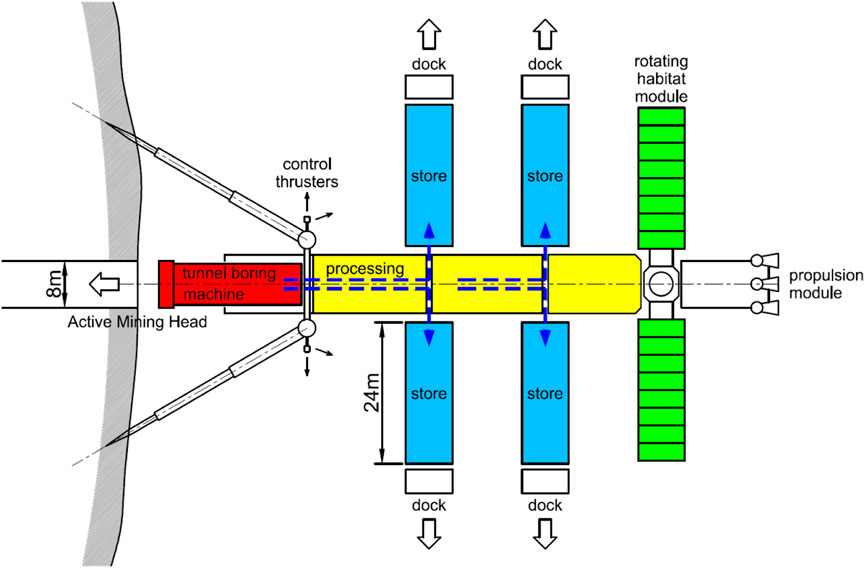
Figure 2. Manned mining station for asteroid mining (schematic) by W. Grandl and Bazso (2013).
Unmanned automated cargo space tugs would transport the material to metallurgical plants and space factories in the Lagrange points of the Earth–Moon system for further processing.
In the far future, we may also utilize the asteroids of the main asteroid belt, the region from 2 to 4 AU between Mars and Jupiter where the overwhelming majority of asteroids of all sizes are located. The overall number of asteroids in the solar system is estimated to be approximately 600,000 objects including Jupiter Trojans (in the Lagrange points of the Jupiter–Sun system) and Trojans of other planets. Asteroids and comets of the outer solar system are thought to contain a large amount of water ice, frozen carbon dioxide, and organic molecules. These natural resources will be very important for human space colonies in the centuries to come.
Orbital debris as a resource for space-based industry
Autino et al. (2023) identified orbital debris as a great future business opportunity; ESA´s Space Debris Office estimates that there are about 36,500 objects larger than 10 cm, 1 million objects between 1 and 10 cm, and approximately 130 million objects 1 mm to 1 cm. The highest concentration of man-made space debris is in low-earth orbit (LEO) and poses a great threat to operating satellites, launchers, and space stations. Developing techniques to collect and reprocess orbital debris in space is urgently needed. While small debris will be hard to collect, the focus lies on objects larger than 10 cm. NASA considers that pulse lasers, for example, could change the velocity and flight track of objects and that physical “sweepers” could collect small particles. Given a space factory in situ, various products can be made from collected debris, such as rocket propellant or metal powder for 3D printing. Several large objects like rocket upper stages and fuel tanks can be reused for storage or to build large structures in space.
The Lagrange space factory (LSF)
The favored locations for an initial space factory are the Lagrange points of the Earth–Moon system. There are five Lagrange points, and these provide an equilibrium between the gravitational forces of the Earth and Moon. Especially in points L4 and L5, an object remains in a stable position because there is a triangle between the object, the Earth, and the Moon. Building the first space factory, for example in L5, will enable us to process material and produce goods in zero or low gravity (Figure 3). In a first stage, the LSF will process orbital debris from Earth orbit, lunar material, and small natural Earth satellites. In 1976, Gerard K. O´Neill proposed an electromagnetic mass driver to catapult containers filled with regolith into lunar orbit or to L1 (O´Neill, 1976).
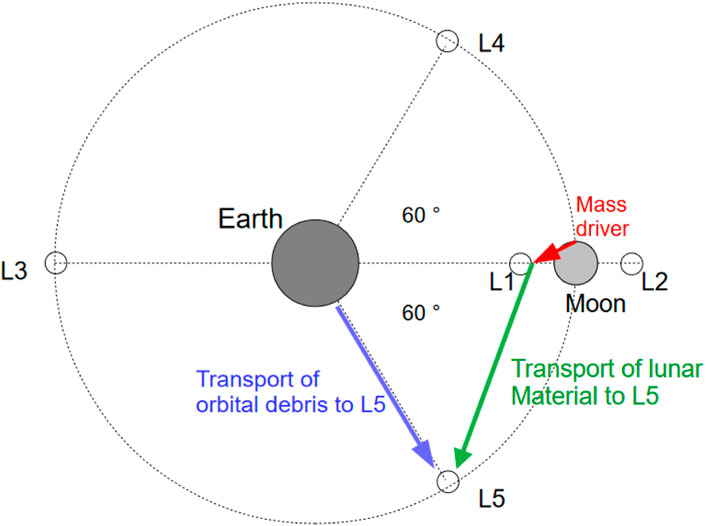
Figure 3. Earth-Moon system and its five Lagrange points; an LSF in L4 or L5 is in a stable position.
The structure of the LSF is modular and can be extended along its major (longitudinal) axis. It starts with a rotating artificial gravity manned unit (AGMU) for a crew of 48 persons. This initial part of the LSF contains eight rotating living quarters modules providing 0.9 g, four zero-g central modules, a docking module, connecting tubes, and a structural framework (Figure 4).
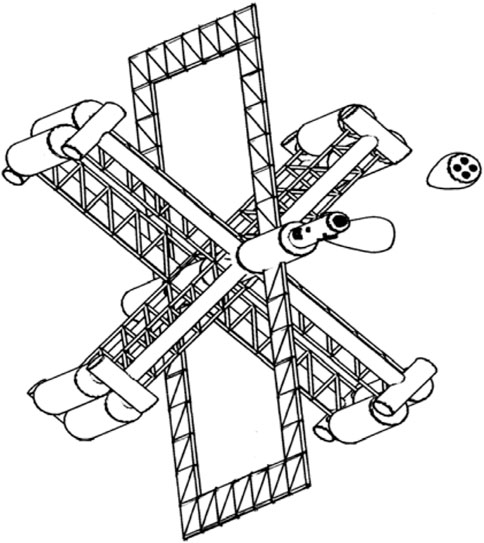
Figure 4. AGMU (derived from the AGOS Artificial Gravity Orbital Station project (Grandl et al., 2023), length 78 m, span 102 m, rotation rate 4.2 rounds per minute.
For transport of the modules from Earth to L5, I propose the use of SpaceX Falcon launchers with a reusable first stage.
In a second step, a triangle-shaped structural framework is added to the initial station. In the centre of this linear structural framework, a central communication tube of 7 m diameter is built. This tube connects all parts of the LSF and is equipped with wiring cables, pipes, and plumbing units. Step-by-step factory units would be built and connected to the central framework, each one 54 m long and 24 × 36 m in diameter. Each factory unit would have a volume of 46,600 m3 and can be equipped with different machinery in a zero-g environment. The central framework, the communication tube, and the factory units are non-rotating and have docking facilities for cargo spaceships (Figures 5, 6).
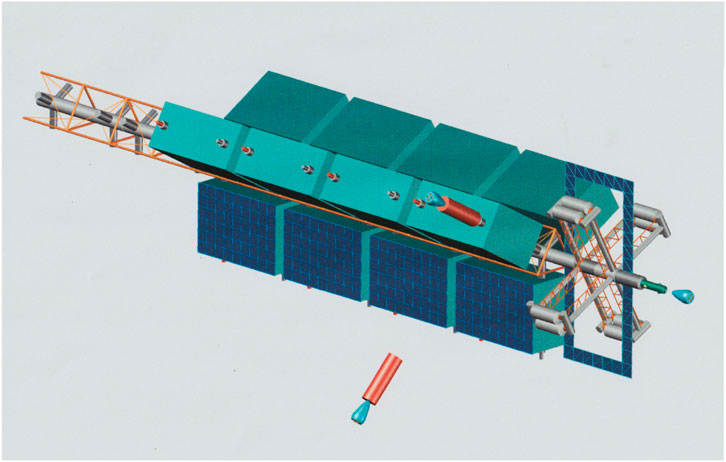
Figure 5. LSF design: 12 factory units fixed to a central structural framework, the initial AGMU for the crew on the right side, the red cargo spaceship is docking.
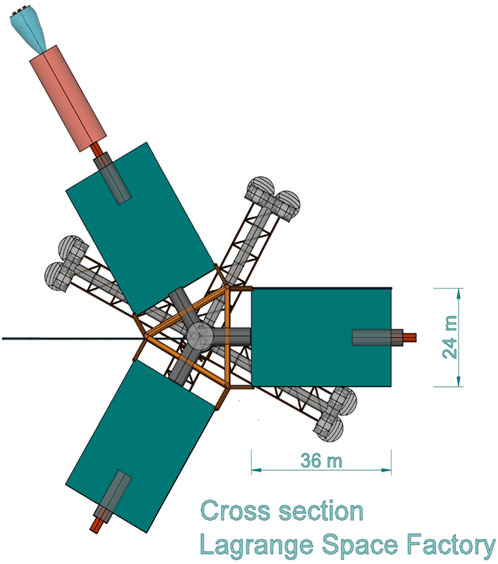
Figure 6. LSF cross section: factory units (green), central framework (orange), cargo spaceship (red), central communication tube, and rotating AGMU (gray).
Transport of material and industrial production
A fleet of unmanned cargo spaceships and robotic space tugs would ship raw material—regolith from the Moon and ore from NEAs—to the LSF. Some of the factory modules would contain metallurgical plants, while others are equipped to produce oxygen and other gases. Additional raw material can be made by processing orbital debris. On the lunar surface, raw material can be packed into cargo containers and catapulted from the lunar surface to lunar orbit or to L1 by an electro-magnetic mass driver. Robotic space-tugs transport the cargo containers from lunar orbit and L1 to the LSF (Figure 7).
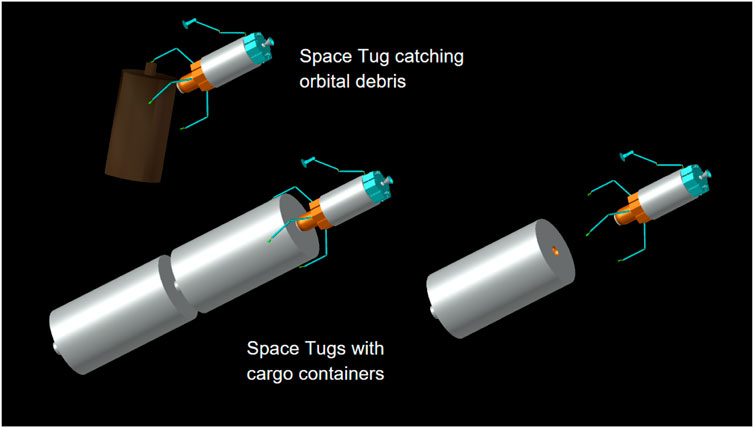
Figure 7. Robotic space-tugs with standardized cargo containers and an orbital debris object © W. Grandl.
Various industrial products and semi-finished goods can be produced in a zero-g environment, such as tubes, trusses, and sheets of steel and aluminium, with oxygen as a by-product of regolith-processing. Regolith and industrial slag can be pressed and sintered to bricks. Rare materials like gold and platinum would be extracted from asteroid ore. Last but not least, orbital debris as an in situ resource (ISRU) can be recycled to produce metal powder for 3D-printing, among other high-tech products. The goal is to produce building material for future human settlements in space, propellant, oxygen, and water on a large scale.
Towards a cis-lunar space economy
The basic structure should be planned and financed by private–public partnership. The basic structure contains the AGMU, the central framework, and the communication tube plus nodes, fittings, and plumbing. The particular factory modules may be financed and constructed by private companies and docked to the central framework (Figure 8). Due to its modular structure, the LSF can be easily elongated to increase and diversify industrial output. Industrial processing, manufacturing, and transport in zero gravity would preferably be by artificial intelligence and robotic machinery supervised by a human crew of engineers and specialized craftsmen.
Any assumption of a possible time scale for the building of large structures in space such as the proposed LSF depends on some important precursory steps.
- New orbital station in LEO (succeeding ISS), preferably with simulated gravity—2035.
- Manned lunar base, including ISRU and an electromagnetic mass driver—2040
- LSF first stage to process lunar material and debris from Earth orbit—2045
- Mining of NEAs, advanced propulsion technologies (e.g., nuclear fusion engines) —2060
- LSF additional stages to process asteroid ores and conglomerates—2065
The dates we have assumed above strictly depend on international cooperation and accurate political decisions by all space-faring nations. Since these political decisions are uncertain, the timeline of 2035–2065 is my estimation as the best-case scenario. Last but not least, some legal questions need to be answered. At the current, time there are varying interpretations of the Outer Space Treaty and the so-called “Moon Agreement” as to the regulatory processes that might apply to the future extraction of resources from the Moon, NEAs, and other celestial bodies (Author anonymous, 1966). The current proposal only intends to examine and set forth the key factors what would support the choice of creating such an industrial facility at L5. Clearly, pending legal and regulatory issues about the international authorization of reclaiming and processing materials will need to be determined in advance of any such space mining and material processing actually taking place. Legal agreements to regulate a future space economy should also contribute to avoiding new frontiers of conflict among space faring nations. According to present space law, celestial bodies can be owned neither by a nation nor a private company. The proposed mining of the Moon and NEAs could be done by private companies with a limited licence to exploit, such as a certain area of the Moon within a definite period.
One more industrial revolution
Our solar system with its planets, moons, and asteroids provides enormous natural resources to be harvested and utilized by humankind. The use of artificial intelligence and robotics in outer space on a large scale will constitute the next “industrial revolution.” Cis-lunar space —the region of the Earth–Moon system—will be the primary target for space industrialization and human settlement. Efficient space flight with reusable rockets on a large scale would signify an essential and giant leap forward in the development of vital activities beyond the productivity of the planet Earth. The money for big space enterprises may be found in the enormous amount of capital and know-how set free by a partial and rational disarmament policy. Opening the gate to extraterrestrial resources can help avoid a struggle for terrestrial resources between different nations. The industrialization of cis-lunar space could become a key factor of disarmament and peaceful international cooperation. In the long run, most mining and heavy industry could be shifted into space to minimize pollution and climate warming on Earth. In the centuries to come, humans will settle on Mars and even beyond, becoming an “interplanetary species” (Elon Musk).
Data availability statement
The original contributions presented in the study are included in the article/supplementary material; further inquiries can be directed to the corresponding author.
Author contributions
WG: Writing – review and editing, Writing – original draft.
Funding
The author(s) declare that no financial support was received for the research and/or publication of this article.
Conflict of interest
The author declares that the research was conducted in the absence of any commercial or financial relationships that could be construed as a potential conflict of interest.
Generative AI statement
The author(s) declare that no Generative AI was used in the creation of this manuscript.
Any alternative text (alt text) provided alongside figures in this article has been generated by Frontiers with the support of artificial intelligence and reasonable efforts have been made to ensure accuracy, including review by the authors wherever possible. If you identify any issues, please contact us.
Publisher’s note
All claims expressed in this article are solely those of the authors and do not necessarily represent those of their affiliated organizations, or those of the publisher, the editors and the reviewers. Any product that may be evaluated in this article, or claim that may be made by its manufacturer, is not guaranteed or endorsed by the publisher.
Abbreviations
AGMU, artificial gravity manned unit; AU, astronomical unit, the Earth–Sun distance; ISRU, In Situ resource utilization; ISS, International Space Station; L1, L2, L3, L4, and L5, Lagrange points; LSF, Lagrange Space Factory; LEO, low-earth orbit; NEAs, near-earth asteroids.
References
Author anonymous (1966). Treaty on principles governing the activities of states in the exploration and use of outer space, including the moon and other celestial bodies, adopted by the general assembly in resolution 2222 (XXI) of December 19, 1966.
Autino, A. V., Grandl, W., Stone, J., and Foing, B. (2022). “Lagrange asteroid city (LAC)- asteropolis: the o´neill´s space urban model revisited,” in 73rd Intern. Astronautical Congress, Paris, France, 18 – 22 September 2022, 18–22.
Autino, A. V., Foing, B., and Anzaldua, A. (2023). “Orbital debris -A great busyness opportunity,” in 74th International Astronautical Congress, Baku, Azerbaijan, 2-6 Oct 2023.
Bussard, R. W. (2002). An advanced fusion energy system for outer planet space propulsion. Space Techno- logy Appl. Int. Forum 608, 768–779. doi:10.1063/1.1449800
Colaprete, A., Schultz, P., Heldmann, J., Wooden, D., Shirley, M., Ennico, K., et al. (2010). Detection of water in the LCROSS ejecta plume. Science 330, 463–468. doi:10.1126/science.1186986
Edmundson, J., and Rickman, D. L. (2012). “A survey of geologic resources,” in Moon- prospective energy and material resources. Editor V. Badescu, 1–21.
Fetter, S. (2010). “Overview of Helium-3 supply and demand,”. Washington DC: Office of Science and Technology Policy.
Grandl, W., and Bazso, A. (2013). “Near Earth asteroids - prospection, mining and habitation,” in Asteroids- prospective energy and material resources. Editor V. Badescu, 633–640.
Grandl, W., Autino, A. V., and Böck, C. (2023). “Artificial gravity orbital station (AGOS)- the simulation of gravity in a rotating space station,” in 74th International Astronautical Congress, Baku, Azerbaijan, 2-6 Oct 2023.
Granvik, M., Jedicke, R., Bryce, B., Chyba, M., Patterson, G., and Picot, G. (2013). “Earth´s temporarily-captured natural satellites-the first step towards utilization of asteroid resources,” in Asteroids-prospective energy and material resources. Editor V. Badescu, 151–167.
Krot, A. N., Keil, K., Goodrich, C. A., Scott, E. R. D., and Weisberg, M. K. (2003). Classification of meteorites. Treatise Geochem. 1, 83–128.
Kuhlman, K. R., and Kulcinski, G. L. (2012). “Helium isotopes in the lunar regolith – measuring helium isotope diffusivity in lunar analogs,” in Moon - Prospective energy and material resources. Editor V. Badescu, 23–56.
McKay, D. S., Heiken, G., Basu, A., Blanford, G., Simon, S., and Reedy, R. (1991). “The lunar regolith,” in Lunar source-book: a user´s guide to the moon, 285–356.
O´Neill, G. K. (1976). The high Frontier- human colonies in space. Princeton, New Jersey: Space Studies Institute Press.
Papike, J. J., Simon, S. B., and Laul, J. C. (1982). The lunar regolith: chemistry, mineralogy and petrology. Rev. Geophys. Space Phys. 20, 761–826. doi:10.1029/rg020i004p00761
Schwandt, C., Hamilton, J. A., Fray, D. J., and Crawford, I. A. (2012). “Oxygen from lunar regolith,” in Moon-prospective energy and material resources. Editor V. Badescu, 165–187.
Shoemaker, E. M., Williams, J. G., Helin, E. F., and Wolfe, R. F. (1979). “Earth-crossing asteroids - orbital classes, collision rates with Earth, and origin,” in Asteroids. Editor T. Gehrels, 253–282.
Keywords: moon, near earth asteroids, space debris, Lagrange points, space mining
Citation: Grandl W (2025) Industrializing the Earth–Moon system: a conceptual study for a space factory at Lagrange point L5. Front. Space Technol. 6:1677693. doi: 10.3389/frspt.2025.1677693
Received: 22 August 2025; Accepted: 08 September 2025;
Published: 02 October 2025.
Edited by:
Joseph N. Pelton, International Space University, United StatesReviewed by:
Victor Vahidi, Alternative Planetary Futures Institute, United StatesCopyright © 2025 Grandl. This is an open-access article distributed under the terms of the Creative Commons Attribution License (CC BY). The use, distribution or reproduction in other forums is permitted, provided the original author(s) and the copyright owner(s) are credited and that the original publication in this journal is cited, in accordance with accepted academic practice. No use, distribution or reproduction is permitted which does not comply with these terms.
*Correspondence: Werner Grandl, YXJjaGlncmFuQGdteC5hdA==
 Werner Grandl
Werner Grandl


